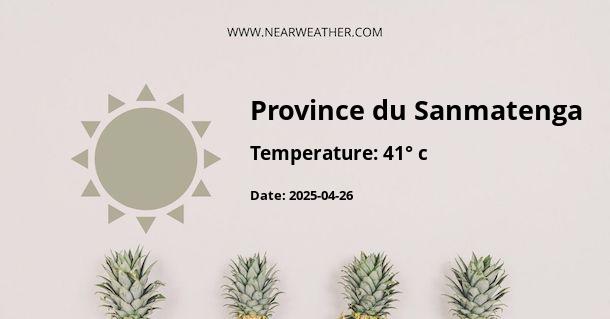Weather
41° 
Climate Conditions: overcast clouds
Humidity: 16%
Wind speed: 9.79 km/h
Wind direction: 171°
Daily Weather Forecast
Saturday
04/26/2025
Climate Conditions: overcast clouds
Humidity: 17%
Sunday
04/27/2025
Climate Conditions: overcast clouds
Humidity: 27%
Monday
04/28/2025
Climate Conditions: overcast clouds
Humidity: 27%
Tuesday
04/29/2025
Climate Conditions: overcast clouds
Humidity: 36%
Wednesday
04/30/2025
Climate Conditions: broken clouds
Humidity: 44%
Evolution
Daily Weather Forecast Evolution (°C)
Lowest temperature
Highest temperature
Other Information
Sunrise
05:45
Sunset
18:18
Latitude
13.250000
Longitude
-1.083330
Timezone: GMT+05:30
More about Province du Sanmatenga:
Climate and Weather in Sanmatenga Province, Burkina Faso
Sanmatenga Province is located in the northern part of Burkina Faso, a landlocked country in West Africa. The province experiences a semi-arid climate characterized by hot and dry conditions for most of the year. In this article, we will explore the climate and weather patterns in Sanmatenga Province throughout the year.Temperature
The temperature in Sanmatenga Province can reach extreme highs during the dry season, which typically lasts from November to May. Daytime temperatures often exceed 40°C (104°F) and can occasionally reach as high as 45°C (113°F). The nights are relatively cooler, with temperatures dropping to around 20°C (68°F). During the rainy season, which occurs from June to October, temperatures are more moderate, ranging from around 25°C (77°F) to 35°C (95°F) during the day. However, the humidity levels tend to be higher during this time, making it feel warmer than it actually is.Rainfall
Sanmatenga Province receives the majority of its rainfall during the rainy season. The average annual precipitation in the province is approximately 800 mm (31.5 inches). The heaviest rainfall occurs between July and September, with August being the wettest month. The rainfall in Sanmatenga Province follows a bimodal pattern, meaning there are two distinct periods of significant precipitation. The first peak occurs in June, while the second peak is in September. However, it is worth noting that rainfall can be highly variable from year to year, and droughts are not uncommon in this region.Dry Season
The dry season in Sanmatenga Province is characterized by hot and arid conditions. The Harmattan wind, which blows from the Sahara Desert, can bring dust and haze to the area, reducing visibility and creating a dry and dusty atmosphere. These conditions can have an impact on agriculture and livestock in the province. During the dry season, water sources become scarce, and vegetation dries up. This can lead to challenges in water availability for both human consumption and agricultural activities. It is important for the local communities to manage water resources efficiently and implement strategies for drought resilience.Wet Season
The wet season in Sanmatenga Province brings much-needed relief from the dry conditions. The rainfall rejuvenates the vegetation and fills up water bodies, providing a source of water for irrigation and livestock. However, heavy rainfall can also lead to flooding in low-lying areas. This can cause damage to infrastructure, crops, and homes. It is crucial for the local authorities to have proper drainage systems in place to mitigate the impact of flooding during the wet season.Agriculture
Agriculture is the main economic activity in Sanmatenga Province, and the climate plays a significant role in determining the success of agricultural practices. Crops such as millet, sorghum, maize, and groundnuts are grown in the province. Farmers in Sanmatenga Province heavily rely on the rainfall patterns to plan their planting and harvesting schedules. The timing and amount of rainfall greatly influence crop yields. Droughts and irregular rainfall can lead to poor harvests and food insecurity in the region.Conclusion
Sanmatenga Province experiences a semi-arid climate with hot and dry conditions during the dry season and moderate temperatures during the rainy season. The province heavily relies on agriculture, and the timing and amount of rainfall play a crucial role in determining agricultural productivity. It is important for the local communities and authorities to implement measures to adapt to the climate challenges and ensure sustainable development in the region. References:- Climate-Data.org. (n.d.). Climate: Sanmatenga. Retrieved from https://en.climate-data.org/africa/burkina-faso/centre-region/sanmatenga-45660/
- UNDP Burkina Faso. (2017). Rapport sur l'analyse de la vulnérabilité et des options d'adaptation aux changements climatiques dans la province du Sanmatenga. Retrieved from http://www.bf.undp.org/content/burkina_faso/fr/home/library/environment_energy/Rapport_sur_l_analyse_de_la_vulnerabilite_et_des_options_d_ada.html
FAQ's about Province du Sanmatenga's Weather:
Q - What is the Latitude and Longitude of Province du Sanmatenga?
A - Province du Sanmatenga's Latitude is 13.250000 & Longitude is -1.083330.
Q - What is the weather in Province du Sanmatenga today?
A - Weather in Province du Sanmatenga is 41° today.
Q - What is the climatic condition of Province du Sanmatenga today?
A - Climate Conditions in Province du Sanmatenga shows overcast clouds today.
Q - What is the humidity in Province du Sanmatenga today?
A - Humidity in Province du Sanmatenga is 16% today.
Q - What is the wind speed in Province du Sanmatenga today?
A - Wind speed in Province du Sanmatenga is 9.79 km/h, flowing at 171° wind direction. today.

Nearby Locations
Latest searched locations